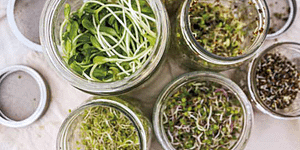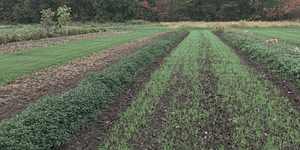No Garden? No Problem! Grow Your Own Salad Indoors

Think you need a vast outdoor garden in order to enjoy fresh produce? Think again! It’s entirely possible to grow your own salad indoors, no matter where you live. If you find yourself dreading heading out to the grocery store for that fresh produce, give indoor gardening a try!
The following is an excerpt from Year-Round Indoor Salad Gardening by Peter Burke. It has been adapted for the web.
Growing soil sprouts runs counter to much of what I always held true about gardening in general. When I try to explain soil sprouts to my farming friends and gardening buddies, they often have trouble understanding the concept at first. I know what bothers them: They think that if they plant 70 sunflower seeds or 150 broccoli seeds, their crop will be enormous compared to the tray of greens I describe.
One farmer complained, “It is so seed intensive.” He thought too many seeds were required, and he dismissed the idea. He reasoned that one mature sunflower could produce easily hundreds of seeds, or each full-grown plant a large head of broccoli. Why harvest the sprouts before they’ve had a chance to produce their full yield?
But when you look at it in a different light, it makes sense. No one would call it “seed intensive” to grind up wheat berries or corn kernels—which are viable seeds—to make bread or object to boiling rice to make dinner. Soil sprouts are just another way—a different way—to eat seeds. Rather than grinding or boiling I grow them for a short time. Plus many of the seed varieties that I grow for greens wouldn’t be used as food themselves, like radish seeds and broccoli seeds.
With my methods, seeds that could only be planted in the outdoor garden in the past can now be used to grow fresh greens indoors. They’ve found a useful place in the pantry as winter food. An indoor salad garden can even work as a full-time garden for those who live in apartments or condominiums with no other place to grow their own food.
Indoor Gardening Takes a Different Approach: Salad Sprouts
The techniques that work for an indoor salad garden of soil sprouts are not the same as those I use for my earth garden. Much of what I had learned about gardening went out the window when I started this project. An indoor garden required an entirely different approach.
For instance, instead of watering the seeds after planting, as I would normally do in my earth garden, I water the seeds before planting by soaking them. Where I usually plant seeds in the soil outdoors, for soil sprouts I scatter the seeds on top of the soil indoors. In my outdoor garden seeds are planted in carefully spaced patterns. For my indoor garden’s soil sprouts I spread the soaked seeds on top of the soil so close together that the seeds touch.
Normally gardeners take pains to provide plenty of light for young plant starts, providing grow lights from the moment the new plants emerge from the soil. It’s a totally opposite approach for soil sprouts; I start them in the dark for 4 days.
For the experienced gardener, it’s a bit of a challenge to go against the grain of years of gardening outdoors. I know it was for me. If this is your first garden and it’s all new, you don’t have the “this-is-how-I-usually- do-it” attitude to overcome. But I should give you fair warning that if your expert gardener friends tell you you’re doing it all wrong, they would be right—that is, if you were growing outdoors!
Just be patient and invite them over for a fresh salad sometime in January, when they’re frozen out of their own gardens.
1. Watering the Seeds First
Presoaking gives the seeds a jumpstart before planting. Usually seeds must soak up enough water from the soil to initiate growth. Depending on the environment it might take days before the seeds even begin to sprout. Although soaking is common to hasten the process of growth for large seeds, with soil sprouts all of the seeds are soaked first, regardless of size. This step is a key to realizing the “fast growth” found in indoor salad gardening.
2. Plant on Top of the Soil 
Planting the seed on top of the soil also saves a day or two because the stem and leaf don’t have to push up through the soil. It also prevents the seed hull and leaves from being covered in soil and keeps the sprout cleaner. Cleaner stems and leaves mean there’s less of a chance the plants will develop damp off (a disease that quickly kills young shoots) or molds, and the greens are easy to clean at harvest time. If you’ve ever cleaned fresh greens from the garden, you’ll appreciate this aspect of soil sprouts.
3. Seeds Are Touching
Outside I would need a 50-foot garden row to plant the same tablespoon of sunflower seeds that I use inside in a small tray that’s only 1⁄8 of 1 square foot in size. By planting the seeds so close that they touch, I get the maximum possible harvest of greens from the smallest possible area. The seed has only enough room to send a root down into the soil and a stem up toward the light, but this is entirely adequate for the short “growing season” of shoots.
4. Grow in the Dark
Growing in the dark also flies in the face of everything I know about vegetable gardening. For my traditional garden I use lights and a cold frame or a greenhouse to give young plants plenty of light in the early stages. But soil sprouts are grown for the stem and first leaves of the plant only, and the first few days of darkness encourage a long stem to grow by “forcing” the seed to search for light.
Outdoors, in more hostile conditions, a seed stem may have to make its way through a pile of leaves or straw before it comes out of the dark. The simulated darkness of a tray with paper covers takes advantage of this natural urge in plants to search for light. It encourages a very productive harvest. Total darkness isn’t necessary; even low-light conditions will do the job of forcing the sprouting seeds to develop long stems in the first stages of growth.
5. Plant Every Day
In my outdoor earth garden I typically plant varieties like tomatoes or squash once per season. For vegetables like lettuce and carrots I do a second planting at mid-season to harvest a fall crop. For varieties like radishes I replant every 2 weeks and enjoy a steady supply of fresh roots all growing season.
With soil sprouts I plant every day. For a steady supply of greens from my indoor salad garden, planting every day is key. I routinely start small batches of seeds, about 5 tablespoons (74 ml) spread over five trays each day. So every day a batch of seeds planted a week ago are coming to harvest. And I know just how many trays I’ll need, week to week, harvesting just what I need each time. I want my indoor salad garden to remain small and manageable, not large or time-consuming.
6. Harvest More from the Seed
As I explained above my objective when growing sprouts in soil is to encourage rapid growth of the stem and a large seed leaf (called a cotyledon). This allows me to harvest nearly all of the stored nutrition from the seed. This general principle has been understood in Asia and elsewhere for many centuries. I was surprised to read an Italian recipe from the year AD 1624 that included radish sprouts, and the English have used cress sprouts for many years, too. Rich in vitamin C, cress sprouts helped sailors to combat scurvy on long voyages. For my indoor salad garden, I’ve included a variety of seeds and developed in-depth techniques to grow soil sprouts full time.
Some mystery still remains, though, even after all these years working with seeds. I’m always excited by the miracle I witness each time I soak them for another batch of sprouts. As soon as I pour the water onto the seeds, it’s off to the races, with all the potential in those little “horses” galloping to the finish line—I can almost hear the cheers!
I’ve learned a lot about seeds and sets from growing soil sprouts; in fact some of the techniques I’ve put to good use in my outdoor garden, too. Take peas, for instance. They’re hardy in the cool Vermont spring, but that’s truer for the plant than the seed. An early, wet spring can make for patchy germination at best, and other times the peas just rot in the soil. One early spring day a few years ago, I realized that I had all these hale and hearty pea sprouts growing indoors in trays, and I wondered, “Why not transplant them outdoors?”
They were an instant success.
I planted two rows of peas, and they had no trouble growing perfectly well, with no setback effect from transplanting. This was especially surprising. The typical book on gardening will tell you that peas do not transplant well!
For many years, I have had an annual bet with a friend of mine: Whoever grows the first 3-inch pea plant wins. He categorically ruled this transplantation technique unfair. For our bet the seeds must be planted directly in the ground outdoors. Still I plant an extra-early batch of peas just for bragging rights—and for the delicious sweet peas, too. Sometimes going against the grain, stepping outside the box and doing something counterintuitive, offers rich rewards. Growing soil sprouts is one of those times.
Recommended Reads
Recent Articles
Want to start your own medicinal herb garden? Passionflower, lemon balm, and goldenseal are great places to begin! These herbs are jam-packed with medicinal properties and easy to grow in a majority of climates.
Read MoreDoes the cold weather have you dreaming about fresh greens and colorful salad? Grow and harvest sprouts indoors to make those dreams a reality! Follow this quick start guide to year-round greens for fresh salad greens in just a couple of weeks! The following is an excerpt from Year-Round Indoor Salad Gardening by Peter Burke. It…
Read MoreAre you ready to get a jump-start on the gardening season? With a cold frame, you can get started now. A cold frame harnesses the sun’s heat before it’s warm enough to let unprotected seedlings growing outside. Essentially, it consists of a garden bed surrounded by an angled frame and covered with a pane of…
Read MoreSprouts are easy to cultivate, mature quickly and pack a nutritional punch! You can make nutrient-rich sprouts from all kinds of edible seeds in your kitchen.
Read MoreWant to make the most of the slow gardening season? Lay cover crops to improve the health of your soil and plants! The following is an excerpt from The Celestial Garden by Jane Hawley Stevens. It has been adapted for the web. Benefits of Cover Crops Cover cropping is a management practice that benefits the…
Read More











